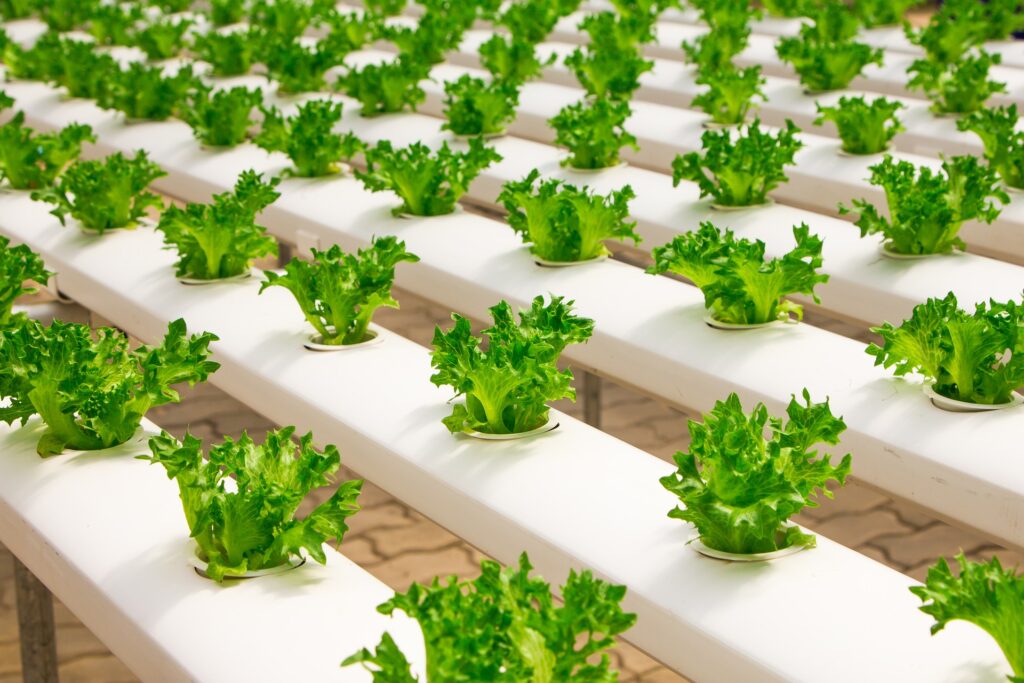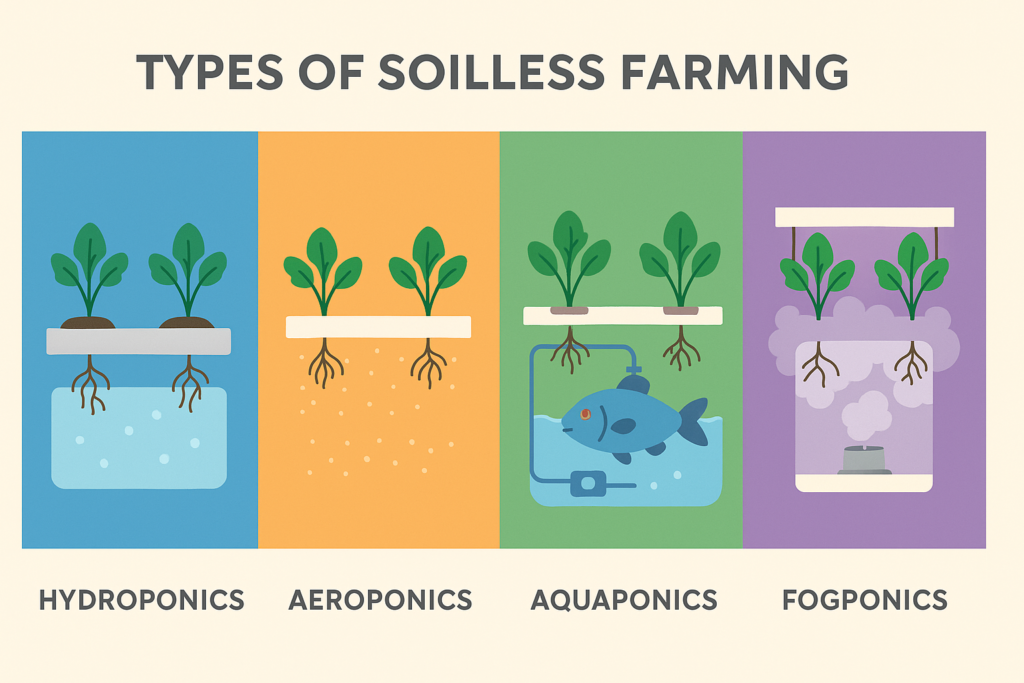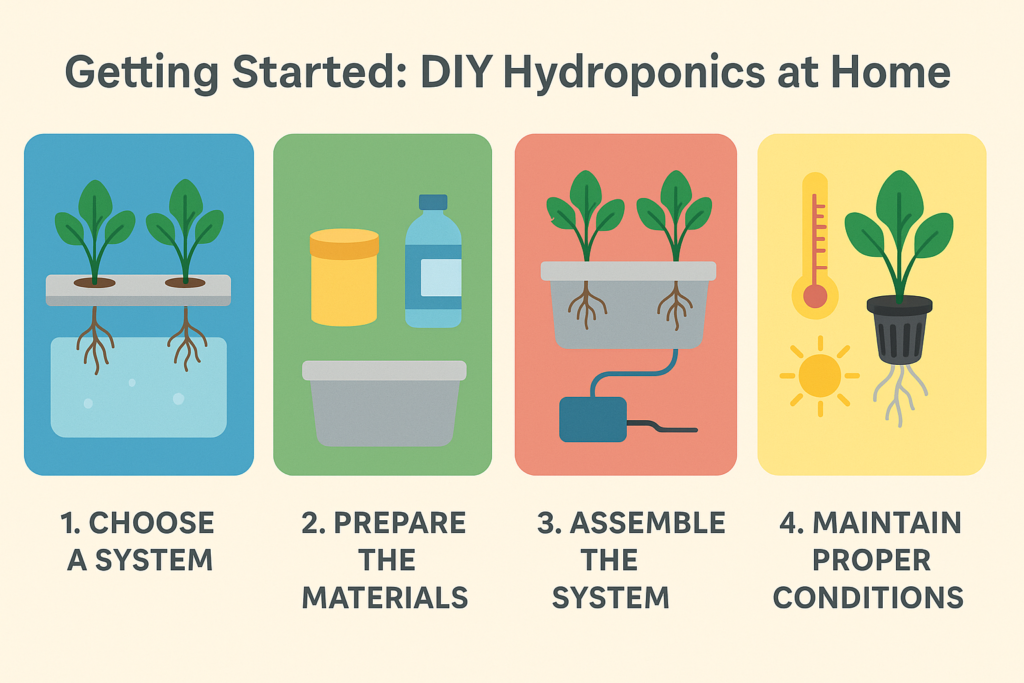Farming Without Soil
Introduction:
For thousands of years, soil was synonymous with agriculture. Ancient civilizations thrived based on how fertile their land was, and modern agriculture has largely followed the same path. However, the 21st century is changing the game. With more than half the world’s population now living in cities, and climate change threatening arable land, farmers and scientists are exploring new ways to feed billions.
One of the most exciting solutions? Growing crops without soil. This revolutionary idea forms the basis of soilless agriculture, where plants receive everything they need to grow nutrients, water, and support without ever touching soil. Through advanced technologies such as hydroponics, aeroponics, and aquaponics, we’re entering a new era of farming that’s more efficient, sustainable, and suitable for the future.

The Science Behind Soilless Farming
Why Do Plants Need Soil Anyway?
Traditionally, plants rely on soil for several essential functions:
Nutrient Supply: Soil contains essential minerals and elements like nitrogen (N), phosphorus (P), and potassium (K) that plants absorb through their roots.
Water Retention: Soil holds water, making it accessible to plant roots over time.
Root Anchorage: Soil provides physical support so that plants remain upright and stable.
Microbial Life: Beneficial bacteria and fungi in soil help plants absorb nutrients and fend off diseases.
However, scientific research has shown that soil is merely a medium. If plants receive water, nutrients, and support from an alternative system, they can grow just as well or even better. Soilless farming is all about engineering these essentials artificially, often with better control and less waste.
Types of Soilless Farming
Hydroponics
Hydroponics is a method of growing plants in a nutrient-rich water solution instead of soil. The roots are either submerged in water or supported by inert materials like rock wool, clay pellets, perlite, or coconut coir. This technique allows for precise control over nutrient delivery, maximizing growth and yield.
Common Hydroponic Systems:
- Deep Water Culture (DWC): Roots float in a reservoir of oxygenated nutrient solution. Ideal for leafy greens like lettuce and spinach.
- Nutrient Film Technique (NFT): A thin film of nutrient solution continuously flows over the roots in a sloped channel. Perfect for herbs and small plants.
- Ebb and Flow (Flood and Drain): Water and nutrients flood the growing tray at intervals and then drain, allowing the roots to absorb what they need.
Pros: Faster growth, no weeds, water-efficient, less space required.
Cons: Requires constant monitoring, electricity, and technical knowledge.
Aeroponics
Aeroponics takes things a step further by suspending plants in air and misting their roots with a fine spray of nutrient-rich water. Developed initially by NASA for space farming, aeroponics provides unmatched oxygen access to roots, leading to faster and more efficient plant growth.
How It Works:
- Plants are anchored in holes on top of an enclosed chamber.
- Inside the chamber, mist nozzles spray nutrient solution onto the roots at timed intervals.
Pros: Extremely water-efficient, no growing medium required, higher nutrient absorption.
Cons: Expensive to set up, highly sensitive to technical failures, power outages can be disastrous.
Aquaponics
Aquaponics is a symbiotic system that combines hydroponics with aquaculture (fish farming). The waste produced by fish supplies organic nutrients for the plants, while the plants purify the water that is then recirculated back to the fish tanks.
Key Components:
- A fish tank with species like tilapia or catfish.
- A grow bed for plants, typically leafy greens or herbs.
- A filtration system to manage solid waste.
Pros: Sustainable, natural fertilizer, low water usage, no chemical inputs.
Cons: More complex to manage, requires balancing both fish and plant health.
Fogponics (Ultraponics)
Fogponics is a variation of aeroponics where nutrients are delivered as a vapor or fog. This ultrafine mist penetrates even the smallest root hairs, enabling maximum absorption of nutrients and water.
Pros: Best nutrient delivery system, extremely efficient.
Cons: Technologically intensive, still under research and development.

Global Adoption: Where Soilless Farming Is Thriving
Singapore
With limited arable land and high food import dependence, Singapore is investing heavily in vertical farms using hydroponics and aeroponics. Companies like Sky Greens use rotating towers that grow leafy vegetables inside climate-controlled buildings.
The Netherlands
A world leader in agricultural innovation, The Netherlands uses high-tech greenhouses and hydroponic systems to produce massive amounts of food. Despite its small size, it is the second-largest exporter of agricultural products globally.
United States
Urban agriculture is booming in American cities. Vertical farms in places like New York and Chicago are producing leafy greens, herbs, and even strawberries using LED lights, automated climate controls, and hydroponic setups.
United Arab Emirates
Faced with extreme heat and barren soil, the UAE has turned to indoor vertical farming and aeroponic greenhouses to meet its food demands. Dubai and Abu Dhabi host some of the world’s largest indoor farms.
Advantages of Soilless Farming
Space Saving: Vertical setups mean you can grow 10 times more food in the same footprint.
Water Efficiency: Uses up to 90% less water than conventional soil-based farming.
Faster Growth Rates: Direct nutrient delivery accelerates growth cycles.
No Soil-Borne Diseases: Reduces pesticide use and crop losses.
Urban Integration: Soilless systems can be built on rooftops, basements, or even inside shipping containers.
Climate Independence: Controlled environments allow for year-round farming, irrespective of weather conditions.
Cleaner Production: Minimal mess, no tilling, and hygienic harvests.
Challenges and Drawbacks
High Initial Investment: LED lights, pumps, and climate controls are costly to install.
Requires Skilled Labor: Staff must understand pH balance, electrical systems, and nutrient management.
Energy Demands: Indoor farms need electricity for lights and HVAC systems.
Crop Limitations: Leafy greens thrive, but cereals, root crops, and fruit trees are harder to manage.
Technical Vulnerabilities: Power or pump failure can kill crops within hours.
Innovations Pushing the Field Forward
AI & Automation
Modern systems use AI to track plant growth, optimize nutrient mixes, and detect problems before they escalate. Automation also reduces labor and human error.
LED Grow Lights
LEDs emit specific light spectrums that match the photosynthesis needs of plants. They consume less energy and produce less heat than traditional lighting systems.
Climate-Controlled Environments
Using sensors and software, growers can maintain optimal temperature, humidity, and CO2 levels inside greenhouses or containers, regardless of outdoor weather.
Modular Farms
Compact, prefabricated farms housed in shipping containers or mobile units. Ideal for cities, disaster zones, or off-grid locations.
What Can Be Grown Without Soil?
Commonly Grown:
- Lettuce
- Spinach
- Kale
- Strawberries
- Basil, mint, oregano, cilantro
- Tomatoes
- Bell Peppers
- Cucumbers
Challenging Crops:
- Root vegetables like carrots and potatoes require depth and volume.
- Grains like wheat and rice need vast land and are economically inefficient in soilless systems so far.
Urban Farming and Food Security
With urbanization accelerating, soilless farming offers a way to:
- Grow food close to where it’s consumed
- Cut transport emissions and costs
- Improve food freshness and nutrition
- Ensure local food resilience in emergencies
- Create green jobs and community engagement
Environmental Impact
- Reduces Land Use: No need to deforest or degrade soil for agriculture.
- Minimizes Water Waste: Recirculation systems reduce consumption and pollution.
- Less Pesticide Use: Enclosed systems are pest-resistant and healthier.
- Lower Carbon Footprint: Urban farms reduce shipping distances.
Fun Fact: Ancient Soilless Farming
The Babylonians’ Hanging Gardens, one of the Seven Wonders of the Ancient World, may have used a form of early hydroponics.
The Aztecs cultivated food on floating islands, or chinampas, in Lake Texcoco. These floating beds were a clever workaround to the lack of arable land.
Getting Started: DIY Hydroponics at Home
Materials Needed:
- A plastic tub or container for the reservoir
- Air pump and tubing for oxygenation
- Net pots and a growing medium (clay pellets or coco coir)
- Nutrient solution (can be bought online)
- Grow lights if indoors
Simple Crops to Start With:
- Lettuce
- Basil
- Mint
- Spinach
Tips:
- Keep pH between 5.5 and 6.5
- Monitor light exposure (12–16 hours/day)
- Regularly clean and check your water system

The Future: Is This the End of Traditional Farming?
While soilless farming is promising, it’s not a complete replacement for traditional agriculture. Large-scale crops like wheat, corn, and rice are still most economically grown in soil. However, for urban areas, water-scarce regions, and future colonies on Mars, soilless systems will be indispensable.
The best future combines both systems soil-based farms for staple crops and soilless farms for perishable, high-value greens grown locally.
Conclusion
Growing crops without soil is no longer science fiction. With technology, innovation, and sustainability at its core, soilless agriculture is transforming how we grow food. From homes and schools to skyscrapers and deserts, these systems can bring fresh, nutritious food closer to everyone.
So the next time you enjoy a crispy salad or fresh basil, it might not be from a farm it might be from a lab, a rooftop, or a shipping container right in your city.